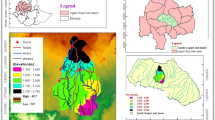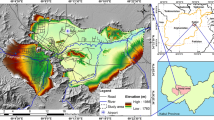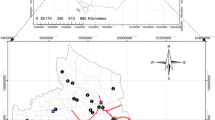Abstract
In arid and semi-arid environments, the amount of recharge received by aquifers is far more critical to the sustainable use of water than it is in humid regions. Groundwater recharge (GWR) is critical to maintain the abundance of groundwater. In the present study, suitable areas for GWR in Jazan region have been identified by using a GIS-based decision support system (DSS). The DSS was implemented to obtain suitability maps and to evaluate the existing GWR in the study area. The DSS inputs comprised maps of rainfall surplus, slope, potential runoff coefficient, land cover/use and soil texture. The spatial extents of GWR suitability areas were identified by a hierarchical process analysis that considered five layers. The model generated a GWR map with four categories of suitability: excellent, good, moderate and poor and unsuitable. The spatial distribution of these categories showed that 50.5 and 31 % of the study area was classified as excellent and good for GWR, respectively, while 16 and 2.5 % of the area were classified as moderate and poor and unsuitable, respectively. Most of the areas with excellent to good suitability have slopes of between 4 and 8 % and are intensively cultivated areas. The major soil type in the excellent to good areas is loamy sand, followed by silt loam, and the rainfall in these areas ranges from 100 to 270 mm. The locations of existing GWR dams were compared with the locations indicated on the generated suitability map using the proximity analysis tool in ArcGIS 10.1. Most (75 %) of the existing GWR structures that were categorised as successful were within the excellent and good areas, followed by moderately suitable (25 %).














Similar content being viewed by others
References
Agarwal R, Garg PK, Garg RD (2013) Remote Sensing and GIS Based Approach for Identification of Artificial Recharge Sites. Water Resour Manag 27(7):2671–2689
Al-Rashed MF, Sherif MM (2000) Water Resources in the GCC Countries: an Overview. Water Resour Manag 14(1):59–75
Anbazhagan S, Ramasamy SM, Das Gupta S (2005) Remote Sensing and GIS for Artificial Recharge Study, Runoff Estimation and Planning in Ayyar Basin, Tamil Nadu, India. Env Geol 48:158–170
Asano T (ed) (1985) Artificial Recharge of Groundwater. Butterworth, Boston, p 767
Babcock HM, Cusing EM (1942) Recharge to Groundwater from Floods in a Typical Desert Wash, Pinal County, Arizona. Trans Am Geophys Union 23:49–56
Beeby-Thompson A (1950) Recharging London’s Water Basin. Timer Review Industry, pp 20–25
Buchen S (1955) Artificial Replenishment of Aquifers. J Inst Water Eng 9:111–163
Chenini I, Mammou AB, El May M (2010) Groundwater Recharge Zone Mapping Using GIS-Based Multi-Criteria Analysis: A Case Study in Central Tunisia (Maknassy Basin). Water Resour Manag 24(5):921–939
Chowdhury A, Jha MK, Chowdary VM, Mal BC (2009) Integrated Sensing and GIS-Based Approach for Assessing Groundwater Potential in West Medinipur District, West Bengal, India. Int J Remote Sens 30(1):231–250
Chowdhury A, Jha MK, Chowdary VM (2010) Delineation of Groundwater Recharge Zones and Identification of Artificial Recharge Sites in West Medinipur District, West Bengal, Using RS, GIS, and MCDM Techniques. Environ Earth Sci 59(6):1209–1222
Dabbagh AE, Abderrahman WA (1997) Management of groundwater resources under various irrigation water use scenarios in Saudi Arabia. Arabian Journal for Science and Engineering, 22 (1 C), 47–64.
Dar IA, Sankar K, Dar MA (2011) Deciphering Groundwater Potential Zones in Hard Rock Terrain Using Geospatial Technology. Environ Monit Assess 173(1–4):597–610
De Winnaar G, Jewitt GPW, Horan M (2007) A GIS-Based Approach for Identifying Potential Runoff Harvesting Sites in the Thukela River Basin, South Africa. Physics and Chemistry of the Earth, Parts A/B/C 32(15):1058–1067
Deepika B, Avinash K, Jayappa KS (2013) Integration of Hydrological Factors and Demarcation of Groundwater Prospect Zones: Insights from Remote Sensing and GIS Techniques. Environmental Earth Sciences 70(3):1319–1338
Dhakate R, Rao VG, Raju BA, Mahesh J, Rao SM, Sankaran S (2013) Integrated Approach for Identifying Suitable Sites for Rainwater Harvesting Structures for Groundwater Augmentation in Basaltic Terrain. Water Resour Manag 27(5):1279–1299
Diamond A, Parteno J (2004) A GIS-based habitat suitability model for the endangered species Red Mulberry (Morus Rubra L.) in the Niagara Region. [Online] URL:<http://www.uoguelph.ca/geography/research/geog4480_w2004/Group13/index htm>
El-Awar FA, Makke MK, Zurayk RA, Mohtar RH (2000) A Hydro-Spatial Hierarchical Method for Siting Water Harvesting Reservoirs in dry. Appl Eng Agric 16(4):395–404
Gandhi AO, Masoom SM (1990) A case history of artificial-recharge by trenching in nalla bed at Sawangi in district of Aurangabad, Maharashtra. In the proceedings volume of the All India seminar on “Modern Techniques of rain water harvesting, water conservation and artificial recharge for drinking water, afforestation, horticulture and agriculture”, pp. 887–894
Garfì M, Tondelli S, Bonoli A (2009) Multi-Criteria Decision Analysis for Waste Management in Saharawi Refugee Camps. Waste Manag 29(10):2729–2739
Ghayoumian J, Ghermezcheshme B, Feiznia S, Noroozi AA (2005) Integrating GIS and DSS for Identification of Suitable Areas for Artificial Recharge, Case Study, Meimeh Basin, Isfahan, Iran. Env Geol 47(4):493–500
Huang CC, Yeh HF, Lin HI, Lee ST, Hsu KC, Lee CH (2013) Groundwater Recharge and Exploitative Potential Zone Mapping Using GIS and GOD Techniques. Environ Earth Sci 68(1):267–280
Jaiswal RK, Mukherjee S, Krishnamurthy J, Saxena R (2003) Role of Remote Sensing and GIS Techniques for Generation of Groundwater Prospect Zones Towards Rural Development: An Approach. Int J Remote Sens 24(5):993–1008
Janssen R, Van Herwijnen M (1994) Multiobjective Decision Support for Environmental Management. Kluwer Academic Publishers, Dordrecht (Netherlands), p 232
Khouri J, Deroubi A (1990) Water Resources in the Arab World. UNESCO/ACSAD, Damascus, p 166
Kumar PK, Gopinath G, Seralathan P (2007) Application of Remote Sensing and GIS for the Demarcation of Groundwater Potential Zones of a River Basin in Kerala, Southwest Coast of India. Int J Remote Sens 28(24):5583–5601
Kumar MG, Agarwal AK, Bali R (2008) Delineation of Potential Sites for Water Harvesting Structures Using Remote Sensing and GIS. J Indian Soc Remote Sens 36:323–334
Liu YB, De Smedt F) 2004 (WetSpa extension, a GIS-based hydrologic model for flood prediction and watershed management. Vrije Universiteit Brussel, Belgium, 1–108.
Malczewski J (2004) GIS-Based Land-use Suitability Analysis: A Critical Overview. Prog Plan 62(1):3–65
Mkiramwinyi FO (2006) Identification of Potential Sites for Rainwater Harvesting Using Remote Sensing and GIS in the Makanya Catchment, Same District, Northern Tanzania. Sokoine University of Agriculture, Morogoro, Tanzania, MSc Thesis
Murthy KSR (2000) Groundwater Potential in a Semi-Arid Region of Andhra Pradesh: A Geographical Information System Approach. Int J Remote Sens 21(9):1867–1884
Nag SK, Ghosh P (2012) Delineation of Groundwater Potential Zone in Chhatna Block, Bankura District, West Bengal, India Using Remote Sensing and GIS Techniques. Environ Earth Sciences 70(5):2115–2127
Nilkalja MV, Masoom SM (1990) Artificial-recharge through underground Bandharas in the proceedings volume of the All India seminar on “Modern Techniques of rain water harvesting, water conservation and artificial recharge for drinking water, afforestation, horticulture and agriculture”, pp. 535–541.
Novaline JRM, Sundaram A, Natarajan T (1993) Watershed Development Using Geographic Information System Techniques. Int J Remote Sens 14:3239–3247
Padmavathy AS, Ganesha RK, Yogarajan N, Thangavel P (1993) Check dam Site Selection Using GIS Approach. Adv Space Res 13(11):123–127
Radulovic M, Stevanovic Z, Radulovic M (2012) A new Approach in Assessing Recharge of Highly Karstified Terrains–Montenegro Case Studies. Environ Earth Sci 65(8):2221–2230
Rahman MA, Rusteberg B, Gogu RC, Lobo Ferreira JP, Sauter M (2012) A new Spatial Multi-Criteria Decision Support Tool for Site Selection for Implementation of Managed Aquifer Recharge. J Environ Manag 99:61–75
Ravi Shankar MN, Mohan G (2005) A GIS Based Hydrogeomorphic Approach for Identification of Site-Specific Artificial-Recharge Techniques in the Deccan Volcanic Province. J Earth Syst Sci 114(5):505–514
Ravishankar MN, Mohan G (2005) A GIS Based Hydrogeomorphic Approach for Identification of Site-Specific Artificial-Recharge Techniques in the Deccan Volcanic Province. J Earth Syst Sci 114(5):505–514
Saaty TL (1977) A Scaling Method for Priorities in Hierarchical Structures. J Math Psychol 15:57–68
Saaty TL (1980) The Analytic Hierarchy Process. NY. USA, McGraw-Hill, New York
Saaty TL (1990) How to Make a Decision: The Analytic Hierarchy Process. Eur J Oper Res 48:9–26
Saaty TL (1994) Fundamentals of Decision-Making and Priority Theory With the Analytic Hierarchy Process. RWS Publications, Pittsburgh, PA, U.S.A
Saaty TL (2008) Decision Making With the Analytic Hierarchy Process. Int J of Serv Scie 1(1):83–98
Saraf AK, Choudhury PR (1998) Integrated Remote Sensing and GIS for Groundwater Exploration and Identification of Artificial Recharge Sites. Int J Remote Sens 19(10):1825–1841
Sargaonkar AP, Rathi B, Baile A (2011) Identifying Potential Sites for Artificial Groundwater Recharge in sub-Watershed of River Kanhan, India. Enviro Earth Sciences 62(5):1099–1108
Saud AG, Mohamed FS, Asif UZ (2013) Saudi Arabia Confronts with Water Scarcity: An Insight. Int J of Water Resour and Arid Environ 2(4):218–225
Sener E, Davraz A, Ozcelik M (2005) An Integration of GIS and Remote Sensing in Groundwater Investigations: A Case Study in Burdur, Turkey. Hydrol J 13:826–834
Shereif HM (2014a) Delineation of potential sites for groundwater recharge using a GIS-based decision support system. Environmental Earth Sciences. doi:10.1007/s12665-014-3249
Shereif HM (2014b) Investigation of rainfall–runoff modeling for Egypt by using remote sensing and GIS integration. CATENA 120:111–121
Shereif HM, Mohammad FS, Alazba AA (2014) Determination of Potential Runoff Coefficient for Al-Baha Region. Saudi Arabia using GIS Arabian journal of Geoscience. doi:10.1007/s12517-014-1303-4
Siebert S, Burke J, Faures JM, Frenken K, Hoogeveen J, Döll P, Portmann FT (2010) Groundwater use for Irrigation–a Global Inventory. Hydrol Earth Syst Sci Discuss 7(3):3977–4021
Soares PV, Pereira SY, Simoes SJC, de Paula BG, Barbosa SA, Trannin ICB (2012) The Definition of Potential Infiltration Areas in Guaratinguetá Watershed, Paraíba do Sul Basin, Southeastern Brazil: An Integrated Approach Using Physical and Land-use Elements. Environ Earth Scie 67(6):1685–1694
Todd DK (1959) Annotated Bibliography on Artificial Recharge of Groundwater Through 1954. USGS Water Supply Paper 1477:115
Vahidnia MH, Alesheikh A, Alimohammadi A, Bassiri A (2008) Fuzzy Analytical Hierarchy Process in GIS Application. Int Arch Photogramm Remote Sens Spat Inf Sci 37(B2):593–596
Acknowledgments
I am grateful to the two anonymous reviewers for their thoughtful comments, which have substantially improved this manuscript.
This project was financially supported by King Saud University, Deanship of Scientific Research, College of Food and Agricultural Sciences Research Centre.
Author information
Authors and Affiliations
Corresponding author
Rights and permissions
About this article
Cite this article
Mahmoud, S.H., Alazba, A.A. & T, A.M. Identification of Potential Sites for Groundwater Recharge Using a GIS-Based Decision Support System in Jazan Region-Saudi Arabia. Water Resour Manage 28, 3319–3340 (2014). https://doi.org/10.1007/s11269-014-0681-4
Received:
Accepted:
Published:
Issue Date:
DOI: https://doi.org/10.1007/s11269-014-0681-4




